Construction Company Introduction Letter
[Your Company's Name]
[Your Company's Address]
[City, State, Zip Code]
[Date]
[Recipient's Name]
[Recipient's Title]
[Recipient's Company]
[Recipient's Address]
[City, State, Zip Code]
Dear [Recipient's Name],
Subject: Introduction to [Your Company's Name] – Your Trusted Construction Partner
I hope this letter finds you well. I am delighted to take this opportunity to introduce [Your Company's Name], a premier construction company with a commitment to excellence and a proven track record of delivering high-quality construction projects.
At [Your Company's Name], we take pride in our dedication to turning innovative ideas into reality. With [number of years] of experience in the industry, our team of skilled professionals possesses the expertise to handle a wide range of construction projects, from residential developments to commercial complexes and industrial facilities.
What sets us apart from the competition is our unwavering focus on customer satisfaction. We believe in building strong, long-lasting relationships with our clients by understanding their unique requirements and delivering projects that exceed their expectations. Our collaborative approach ensures that clients are involved at every stage of the construction process, ensuring transparency and successful project outcomes.
Our comprehensive range of construction services includes:
1. Design and Planning: Our team of architects and engineers work closely with clients to conceptualize and design projects that align with their vision and objectives.
2. Construction Management: From project initiation to completion, we diligently manage all aspects of the construction process, ensuring adherence to timelines and budgets.
3. General Contracting: As a licensed and insured general contractor, we have the capability to handle complex construction projects with the highest level of professionalism.
4. Renovation and Remodeling: We breathe new life into existing structures through innovative renovation and remodeling solutions.
5. Quality Assurance: Our stringent quality control measures guarantee that the finished product meets the highest standards of craftsmanship and durability.
6. Safety: The safety of our team members, clients, and the public is of paramount importance, and we strictly adhere to all safety regulations and best practices.
We believe in utilizing the latest construction technologies and sustainable practices to minimize our environmental impact and contribute positively to the communities we serve.
We have successfully completed a diverse portfolio of projects, and I invite you to review our website [Your Website URL] for more information and to view some of our past work.
If you have any upcoming construction projects or if there's any way we can assist you, please do not hesitate to contact us at [Your Contact Number] or [Your Email Address]. We would be honored to be your construction partner and help you realize your vision.
Thank you for considering [Your Company's Name] as a potential partner. We look forward to the opportunity to collaborate and create remarkable constructions together.
Sincerely,
[Your Name]
[Your Title]
[Your Company's Name]
[Your Contact Number]
[Your Email Address]
Introduction to New Client or Potential Partner
Subject: Introducing [Company Name] - Your Construction Partner
Dear [Recipient Name],
I am writing to introduce [Company Name], a full-service construction company with [X] years of experience delivering quality projects across [residential/commercial/industrial] sectors. We specialize in [specific services: general contracting, renovations, custom builds, etc.] and have built a reputation for excellence in [your region/city].
Our team consists of licensed professionals, skilled craftsmen, and project managers dedicated to bringing visions to life while adhering to strict timelines and budgets. We have successfully completed over [number] projects, ranging from [type of projects] to [type of projects], with a client satisfaction rate of [percentage]%.
What sets us apart is our commitment to transparent communication, sustainable building practices, and innovative solutions that maximize value. We utilize cutting-edge technology for project management and maintain comprehensive insurance coverage to protect all stakeholders.
I would welcome the opportunity to discuss how we can support your upcoming construction needs. Our portfolio and client references are available upon request, and we would be happy to schedule a consultation at your convenience.
Thank you for considering [Company Name] as your construction partner. I look forward to the possibility of working together.
Warm regards,
[Your Name]
[Your Title]
[Company Name]
[Phone Number]
[Email Address]
Introduction for Bid Submission (Formal)
Subject: Construction Bid Submission - [Project Name]
Dear [Project Manager/Selection Committee],
[Company Name] is pleased to submit our bid for the [Project Name] as outlined in RFP [number]. As an established construction firm with [X] years of proven expertise in [relevant sector], we are confident in our ability to deliver this project to the highest standards.
Our company holds all necessary licenses and certifications, including [list relevant licenses], and maintains [amount] in liability insurance. We have successfully completed similar projects, including [brief examples], demonstrating our capacity to handle projects of this scope and complexity.
Our bid reflects a comprehensive understanding of your project requirements, including [mention specific aspects: timeline, budget constraints, technical specifications]. We have assembled a dedicated team led by [Project Manager name], who brings [X] years of experience in comparable projects.
We commit to completing this project within [timeframe] while maintaining strict adherence to safety protocols, quality standards, and environmental regulations. Our approach emphasizes proactive communication, risk mitigation, and value engineering to ensure optimal outcomes.
Enclosed you will find our detailed proposal, financial statements, bonding capacity documentation, and references from similar projects. We are prepared to begin work immediately upon contract award and welcome the opportunity to discuss our proposal in detail.
Thank you for considering [Company Name] for this important project.
Respectfully,
[Your Name]
[Your Title]
[Company Name]
[Contact Information]
Introduction to Subcontractor or Supplier (Professional)
Subject: Establishing Partnership - Construction Services
Hello [Recipient Name],
I'm reaching out from [Company Name] to introduce our construction firm and explore potential collaboration opportunities. We are a growing company specializing in [types of projects] throughout [region], and we're always seeking reliable subcontractors and suppliers to join our network.
We've heard excellent things about [their company] through [source/industry contacts], and your expertise in [their specialty] aligns perfectly with our project needs. We typically work on [number] projects annually, with values ranging from [amount] to [amount], and we're looking for partners who share our values of quality, reliability, and professionalism.
Our payment terms are [terms], and we pride ourselves on maintaining strong, long-term relationships with our trade partners. We believe in fair pricing, clear communication, and timely payments - because we know that successful projects depend on successful partnerships.
Would you be interested in scheduling a brief meeting to discuss how we might work together? I'd love to learn more about your capabilities, pricing structure, and availability for upcoming projects.
Looking forward to connecting,
[Your Name]
[Your Title]
[Company Name]
[Phone Number]
[Email Address]
Introduction After Referral (Casual Professional)
Subject: [Referrer Name] Suggested We Connect
Hi [Recipient Name],
[Referrer Name] mentioned you're looking for a reliable construction company for [project type/upcoming project], and they thought we'd be a great fit. I wanted to reach out and introduce myself and [Company Name].
We've been in business for [X] years, focusing primarily on [specialization]. Our approach is pretty straightforward - we listen to what you want, provide honest assessments, and deliver quality work without the usual construction headaches. No surprises, no excuses.
Some recent projects include [brief examples], and we've built a solid reputation for [key strengths: finishing on time, staying on budget, problem-solving, etc.]. We're fully licensed, insured, and bonded, and we can provide references from clients who've been in similar situations.
If you're interested, I'd love to grab a coffee or do a quick site visit to discuss your project. No pressure, no obligation - just a conversation to see if we're the right fit for what you need.
Feel free to call or text me directly at [phone number], or just reply to this email.
Thanks,
[Your Name]
[Your Title]
[Company Name]
Introduction to Property Developer or Real Estate Firm (Strategic)
Subject: Strategic Partnership Opportunity - Construction Services
Dear [Recipient Name],
As [region's/city's] real estate market continues to expand, [Company Name] is seeking to establish strategic partnerships with forward-thinking developers who value quality construction and reliable project execution. I believe [their company] and [Company Name] could create significant mutual value.
Our construction company specializes in [multi-family residential/commercial/mixed-use] developments, with particular expertise in [specific capabilities: ground-up construction, adaptive reuse, value engineering, etc.]. We have the capacity to manage multiple concurrent projects and the financial stability to support large-scale developments.
What makes us an ideal partner:
- Proven track record with [number] completed developments totaling [square footage/units]
- In-house teams that reduce coordination delays and costs
- Strong relationships with permitting authorities and inspectors
- Creative problem-solving that has saved our partners an average of [percentage]% on project costs
- Bonding capacity up to [amount]
We understand that developers need more than just a contractor - you need a partner who thinks like an owner, anticipates challenges, and protects your investment. That's exactly what we deliver.
I'd welcome the opportunity to present our capabilities and discuss how we can support your development pipeline. Are you available for a meeting in the coming weeks?
Best regards,
[Your Name]
[Your Title]
[Company Name]
[Contact Information]
Introduction to Government Agency or Municipality (Official)
Subject: Construction Services - [Company Name] Qualifications
Dear [Department Head/Procurement Officer],
[Company Name] respectfully submits this letter of introduction to be considered for public construction projects administered by [Agency/Municipality Name]. We are a certified [relevant certifications: DBE, MBE, WBE, veteran-owned, etc.] contractor with comprehensive experience in public sector construction.
Our qualifications include:
- [X] years of experience with government contracts at [local/state/federal] levels
- Current certifications: [list all relevant certifications]
- Bonding capacity: [amount]
- Annual revenue: [amount]
- Key personnel with security clearances (if applicable)
We have successfully completed [number] public projects, including [examples], demonstrating our ability to navigate prevailing wage requirements, compliance documentation, public bidding processes, and stringent oversight protocols. Our safety record exceeds industry standards with an EMR of [number].
[Company Name] maintains full compliance with all applicable regulations, including [relevant laws/requirements], and we have established protocols for Davis-Bacon Act compliance, certified payroll reporting, and EEO documentation.
We request inclusion in your qualified bidders list for projects within our scope of [project types and size ranges]. We have enclosed our Statement of Qualifications, financial statements, bonding letters, and current insurance certificates for your review.
Thank you for considering [Company Name] for future opportunities to serve [jurisdiction].
Respectfully submitted,
[Your Name]
[Your Title]
[Company Name]
[Contact Information]
Introduction to Architect or Engineering Firm (Collaborative)
Subject: Building Better Projects Together
Dear [Recipient Name],
Great design deserves great execution. That's why I'm reaching out to introduce [Company Name] and explore opportunities to collaborate on upcoming projects.
We're a construction company that genuinely values the design-build relationship. Too often, contractors see themselves as adversaries to architects and engineers, but we know that the best projects happen when construction expertise informs design from the earliest stages.
Our team brings [X] years of building experience across [project types], and we've learned that early contractor involvement leads to better outcomes: more buildable designs, accurate budgets, fewer change orders, and happier clients. We offer preconstruction services including constructability reviews, value engineering, and budget development - often at no cost for projects we'll eventually build.
We'd love to be a resource for your firm, whether that means providing preliminary pricing, reviewing details for constructability, or serving as your contractor of choice for design-build projects. We work collaboratively, respect the design intent, and communicate proactively to solve problems before they become crises.
Could we schedule a time to meet and discuss how we might support your projects? I'd enjoy learning about your current work and sharing examples of successful architect-contractor partnerships we've built.
Looking forward to connecting,
[Your Name]
[Your Title]
[Company Name]
[Contact Information]
Introduction to Insurance Company or Restoration Work (Specialized)
Subject: Emergency Restoration & Insurance Reconstruction Services
Dear [Recipient Name],
[Company Name] specializes in emergency restoration and insurance reconstruction services, and I'm writing to introduce our capabilities to [Insurance Company Name]. We understand that your policyholders need fast, reliable, and professional service during stressful situations, and we're equipped to deliver exactly that.
Our services include:
- 24/7 emergency response for fire, water, and storm damage
- Complete reconstruction from mitigation through final restoration
- Direct insurance billing and Xactimate estimating
- Licensed, bonded, and insured with comprehensive coverage
- In-house crews for faster mobilization and quality control
We've worked with [other insurance companies/adjusters] on [number] claims, maintaining a reputation for accurate estimates, transparent communication, and quality workmanship. Our project managers are experienced in navigating the claims process and understand the documentation requirements that make your job easier.
What sets us apart is our commitment to treating policyholders with compassion while protecting the insurance company's interests through efficient, cost-effective repairs. We complete projects an average of [timeframe] faster than industry standards, reducing ALE costs and improving customer satisfaction.
We would welcome the opportunity to be added to your preferred contractor list. I've enclosed our company information, insurance certificates, and references from adjusters and policyholders we've served.
Thank you for considering [Company Name] as a trusted restoration partner.
Sincerely,
[Your Name]
[Your Title]
[Company Name]
[24/7 Emergency Line]
[Email Address]
What is a Construction Company Introduction Letter and Why Send One?
A construction company introduction letter is a formal or semi-formal business communication that presents your construction firm to potential clients, partners, or collaborators. The purpose behind this letter is multifaceted:
- Establishing first contact with prospects who may need construction services
- Creating awareness of your company's existence, capabilities, and unique value proposition
- Opening doors for future business opportunities and partnerships
- Building credibility by presenting your qualifications, experience, and professional standing
- Differentiating your company from competitors in a crowded marketplace
- Initiating relationships that can lead to project opportunities, subcontracting work, or strategic alliances
- Positioning your firm for specific opportunities such as bid invitations or preferred vendor status
The letter serves as your company's first impression and can be the difference between being considered for a project or being overlooked entirely.
Who Should Send Construction Company Introduction Letters?
- Company owners who want to personally convey their commitment to quality and service
- Business development managers responsible for generating new leads and opportunities
- Project managers when introducing themselves for specific project opportunities
- Marketing directors executing strategic outreach campaigns
- Estimators when submitting bids that require company background information
- Regional managers expanding into new territories or markets
- Partnership directors seeking strategic alliances with suppliers, subcontractors, or developers
- Sales representatives assigned to specific territories or client segments
The sender should have authority to represent the company and make commitments on its behalf. For maximum impact, letters should come from the highest appropriate level within the organization.
When Should You Send a Construction Company Introduction Letter?
- Entering new markets or geographic regions where your company is unknown
- After receiving a referral from an existing client or business contact
- Before bidding on projects with organizations unfamiliar with your work
- When launching new services or capabilities that expand your offerings
- After major milestones such as completing significant projects or receiving awards
- During slow periods to proactively generate leads rather than waiting for opportunities
- Following networking events where you made promising connections
- When targeting specific clients identified through market research or strategic planning
- After company changes such as rebranding, leadership transitions, or certifications acquired
- In response to RFQs (Requests for Qualifications) that require company background
- Quarterly or annually as part of systematic business development efforts
- When suppliers or subcontractors are needed for your upcoming project pipeline
Formatting Guidelines for Construction Company Introduction Letters
- Length: Keep letters between 250-500 words; one page maximum for printed letters
- Tone: Match the recipient and situation - formal for government/large corporations, professional-casual for small businesses
- Structure: Use short paragraphs (2-4 sentences) for easy scanning and readability
- Subject line: Make it specific and relevant for emails; avoid generic phrases like "Introduction"
- Personalization: Always address specific individuals by name rather than "To Whom It May Concern"
- White space: Use adequate spacing between paragraphs for visual appeal
- Font: Professional fonts like Arial, Calibri, or Times New Roman in 11-12 point size
- Company branding: Include logo, colors, and letterhead for printed correspondence
- Contact information: Make it prominently visible and include multiple contact methods
- Specificity: Include concrete numbers, project examples, and credentials rather than vague claims
- Call to action: End with a clear next step (meeting request, phone call, portfolio review)
- Attachments: Reference any enclosed materials (portfolio, certifications, insurance documents)
- Proofreading: Ensure zero errors - mistakes undermine credibility in construction communications
Common Mistakes to Avoid When Writing Introduction Letters
- Being too generic - failing to customize the letter for the specific recipient or opportunity
- Overpromising - making claims about capabilities or timelines you cannot realistically deliver
- Focusing on yourself - talking only about your company instead of the recipient's needs
- Including too much technical jargon - using industry terms that non-construction recipients may not understand
- Neglecting research - sending letters without understanding the recipient's business or recent projects
- Poor timing - sending letters during busy periods or after opportunities have closed
- Forgetting follow-up - failing to mention or execute next steps after sending
- Using outdated information - referencing old projects, expired certifications, or former team members
- Skipping proofreading - sending letters with typos, grammatical errors, or incorrect recipient information
- Being too pushy - demanding immediate responses or meetings rather than inviting dialogue
- Omitting credentials - failing to mention licenses, insurance, bonding capacity, or relevant certifications
- Writing too much - creating lengthy letters that recipients won't read completely
- Weak closing - ending without a clear call to action or next steps
- Ignoring format - sending poorly formatted emails or unprofessional-looking printed letters
Elements and Structure of an Effective Introduction Letter
Essential opening elements:
- Clear, relevant subject line that indicates purpose
- Personalized greeting addressing recipient by name and title
- Immediate statement of purpose in the first sentence
Body components:
- Company overview - brief history, specialization, and market position
- Relevant experience - specific examples and project types that match recipient's needs
- Differentiators - what makes your company unique or superior
- Credentials - licenses, certifications, insurance, bonding capacity
- Key personnel - team members relevant to potential projects
- Value proposition - specific benefits the recipient will gain
Supporting information:
- Quantifiable achievements (completion rates, safety records, client satisfaction)
- Technology or methodologies that enhance service delivery
- Geographic coverage or market reach
- Financial stability indicators
Closing elements:
- Clear call to action (meeting request, phone call, portfolio review)
- Multiple contact methods with direct lines
- Professional signature with full contact information
- Professional title and company name
Attachments to consider:
- Company brochure or one-page capability statement
- Project portfolio or case studies
- Client reference list
- Insurance certificates and bonding letters
- Relevant certifications or licenses
- Financial statements (for large projects or public work)
Tips and Best Practices for Maximum Impact
- Research thoroughly - understand the recipient's business, recent projects, and pain points before writing
- Lead with value - immediately explain what you can do for them, not what you want from them
- Use specific numbers - concrete data (years in business, projects completed, safety statistics) builds credibility
- Tell stories briefly - short examples of similar projects demonstrate relevant experience
- Customize ruthlessly - create templates but heavily modify each letter for the specific recipient
- Time strategically - send letters when recipients are planning projects, not during peak busy seasons
- Follow up systematically - plan 2-3 follow-up touches over several weeks
- Include social proof - mention mutual connections, similar clients you've served, or industry recognition
- Make it scannable - use bold text sparingly to highlight key points for quick reading
- Offer immediate value - provide a free consultation, site assessment, or preliminary estimate
- Show personality - let your company culture and values come through appropriately
- Use active voice - "We completed 47 projects" instead of "47 projects were completed by our company"
- Create urgency softly - mention upcoming capacity or limited availability without being pushy
- Leverage technology - use professional email tracking to know when letters are opened
- Build sequences - plan multi-touch campaigns rather than single letters for better response rates
After Sending Your Introduction Letter: Follow-Up Strategy
- Track delivery - confirm emails were received or letters were delivered
- Wait appropriately - give recipients 3-5 business days before first follow-up
- Follow up persistently - plan for 3-7 touches across multiple channels (email, phone, LinkedIn)
- Add value with each contact - share relevant articles, industry insights, or project examples
- Vary your medium - alternate between email, phone calls, and social media connections
- Reference the original letter - remind recipients of your initial introduction
- Offer something new - propose a site visit, free estimate, or consultation in follow-ups
- Respect boundaries - if someone declines or doesn't respond after multiple attempts, move on professionally
- Document interactions - keep records of all communications for future reference
- Nurture long-term - add non-responders to newsletters or quarterly update lists
- Request referrals - even if the recipient doesn't need services, ask who might
- Update your materials - refresh letters periodically with new projects and achievements
- Measure results - track response rates to refine future introduction letter campaigns
- Set reminders - schedule future check-ins with promising contacts even if timing isn't right currently
Requirements and Prerequisites Before Sending
- Updated credentials - ensure all licenses, certifications, and insurance policies are current
- Professional materials - have polished portfolio, brochures, and capability statements ready
- Reference list - prepare 5-10 recent clients willing to provide recommendations
- Digital presence - ensure website, LinkedIn, and online reviews present professional image
- Clear value proposition - articulate what differentiates your company from competitors
- Defined target audience - identify who you're contacting and why they're a good fit
- Contact information verified - confirm recipient names, titles, and addresses are accurate
- Availability to respond - ensure you can promptly handle inquiries that result from letters
- Marketing materials - have leave-behinds, portfolios, or digital presentations ready for follow-up meetings
- Internal alignment - make sure your team knows about outreach efforts and can support them
- Financial readiness - verify you have bonding capacity and cash flow to take on new work
- Legal compliance - confirm all business registrations, workers' compensation, and required documentation current
Pros and Cons of Sending Introduction Letters
Advantages:
- Low-cost marketing - minimal expense compared to advertising or trade shows
- Targeted outreach - reach specific decision-makers rather than broad audiences
- Professional positioning - demonstrates proactive business development approach
- Relationship building - starts conversations that can develop over time
- Competitive advantage - gets your name in front of prospects before competitors
- Flexibility - easily customized for different audiences and situations
- Measurable results - can track responses and refine approach
- Door opener - creates opportunities for follow-up conversations and meetings
Disadvantages:
- Low response rates - many recipients won't respond to unsolicited introductions
- Time investment - properly customized letters require significant research and writing time
- Delayed results - may take months before letters generate actual project opportunities
- Easy to ignore - emails can be deleted and letters discarded without reading
- Competition - recipients likely receive similar letters from other contractors
- Requires follow-up - letters alone rarely generate business without persistent follow-through
- Reputation risk - poorly written or researched letters can damage rather than build credibility
Comparison with Alternative Approaches
Introduction letters vs. Cold calling:
- Letters are less intrusive and allow recipients to respond at their convenience
- Phone calls enable immediate dialogue but face higher rejection rates
- Letters provide written record of credentials; calls require follow-up documentation
Introduction letters vs. Networking events:
- Events enable face-to-face connection but reach fewer people
- Letters scale better for reaching large numbers of prospects
- Combining both approaches maximizes effectiveness
Introduction letters vs. Digital advertising:
- Letters are more personal and targeted to specific decision-makers
- Advertising reaches broader audiences but with less relevance
- Letters typically generate higher-quality leads though fewer in number
Introduction letters vs. Referral requests:
- Referrals carry more credibility and generate higher response rates
- Introduction letters enable outreach when referrals aren't available
- Both approaches should be used complementarily
Email vs. Printed letters:
- Emails are faster, cheaper, and easier to track
- Printed letters stand out more and convey greater formality
- Consider recipient preferences and industry norms when choosing
Frequently Asked Questions
How long should I wait for a response before following up? Wait 3-5 business days after email delivery, or 7-10 days after mailing printed letters, before your first follow-up attempt.
Should I include pricing information in introduction letters? Generally no - introduction letters establish credibility and relationships; pricing discussions come later after understanding specific needs.
How many companies should I contact in a single campaign? Quality over quantity - 20-30 well-researched, highly customized letters outperform 200 generic ones.
Can I send the same letter to multiple people at one organization? Avoid this - it appears unprofessional. Research the appropriate decision-maker and send one customized letter.
What's the best day and time to send introduction emails? Tuesday through Thursday, mid-morning (9-11 AM) typically see highest open rates, avoiding Mondays and Fridays.
Should I mention specific projects I want to bid on? Yes, if you're aware of upcoming projects - it demonstrates research and makes the letter more relevant.
How do I find the right person to address my letter to? Research company websites, LinkedIn, call reception, or check industry directories for accurate names and titles.
What if I don't have much experience yet? Focus on credentials, team expertise, partnerships with experienced firms, and enthusiasm for learning and quality delivery.
Should I include attachments with my initial letter? Mention attachments are available upon request, but avoid large email attachments that may be blocked or ignored.

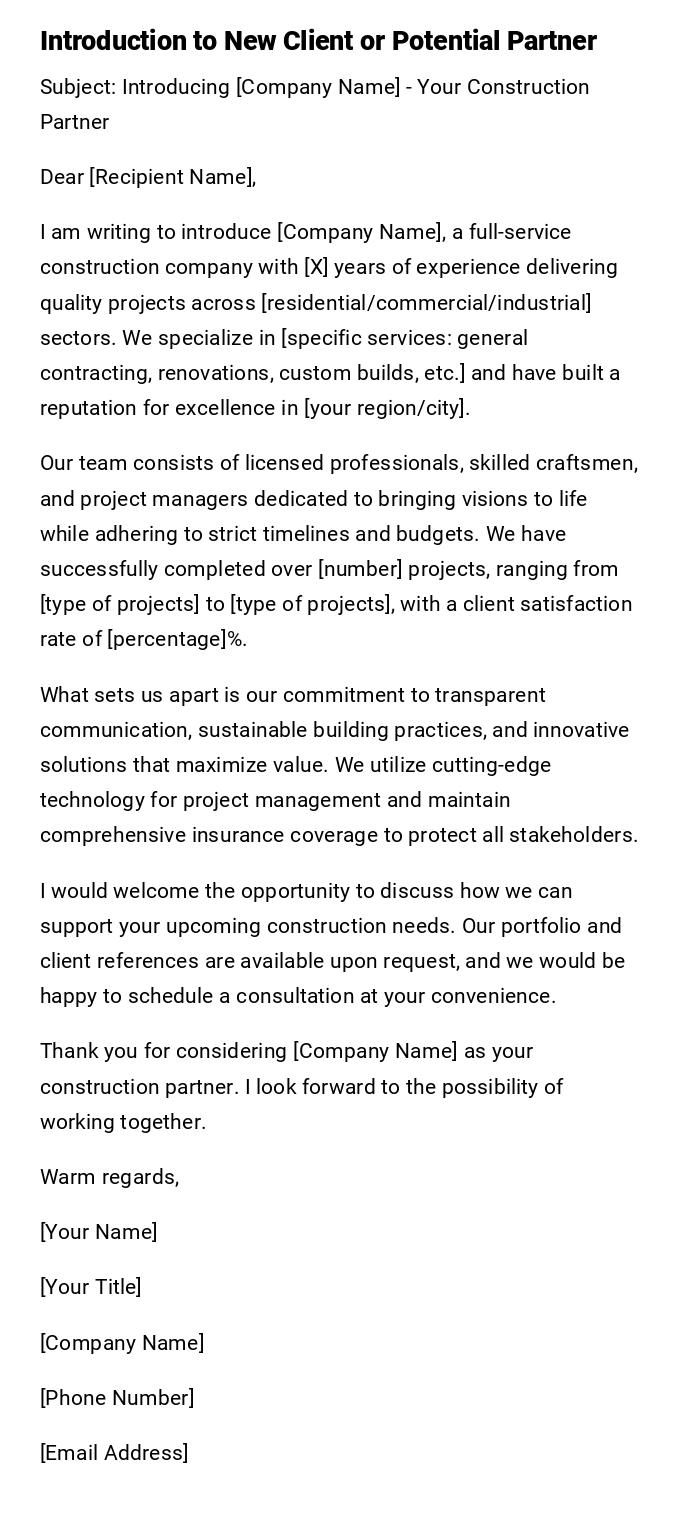
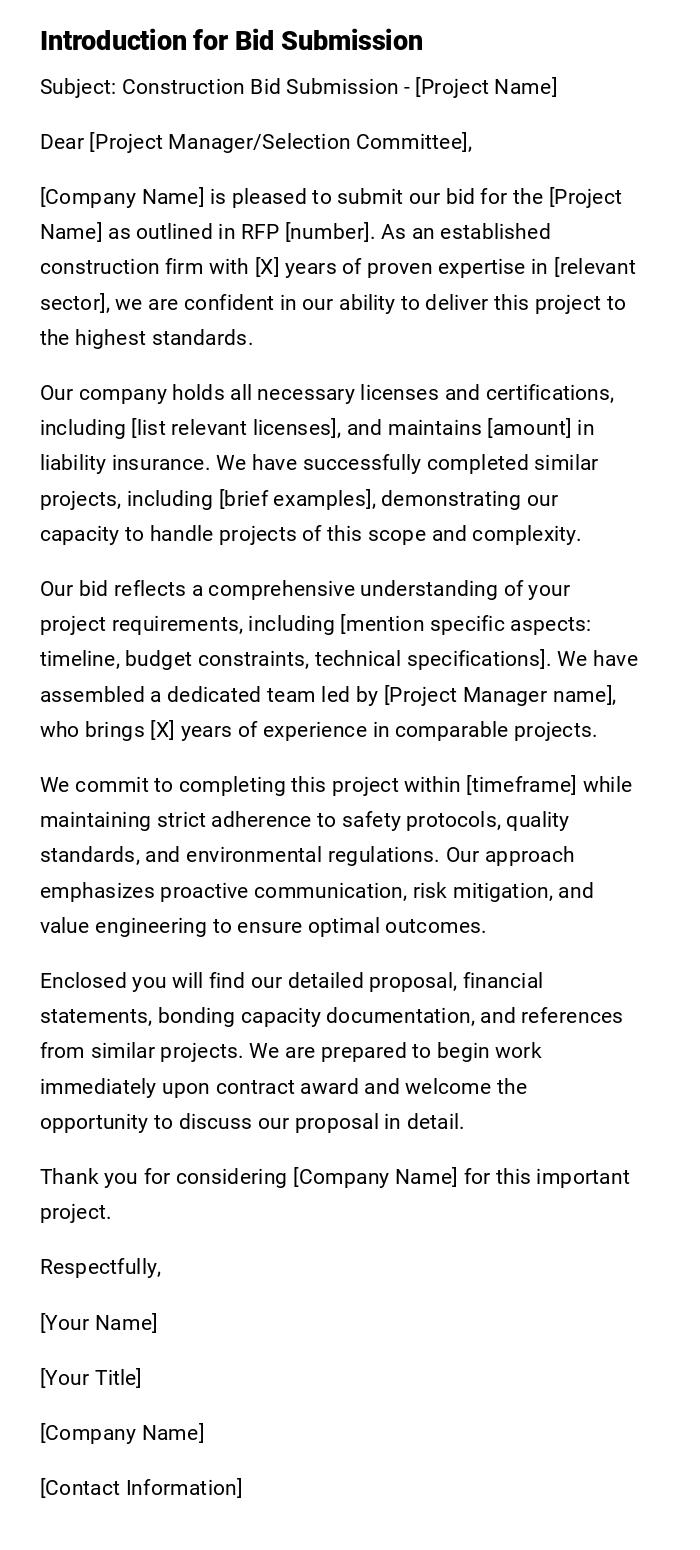
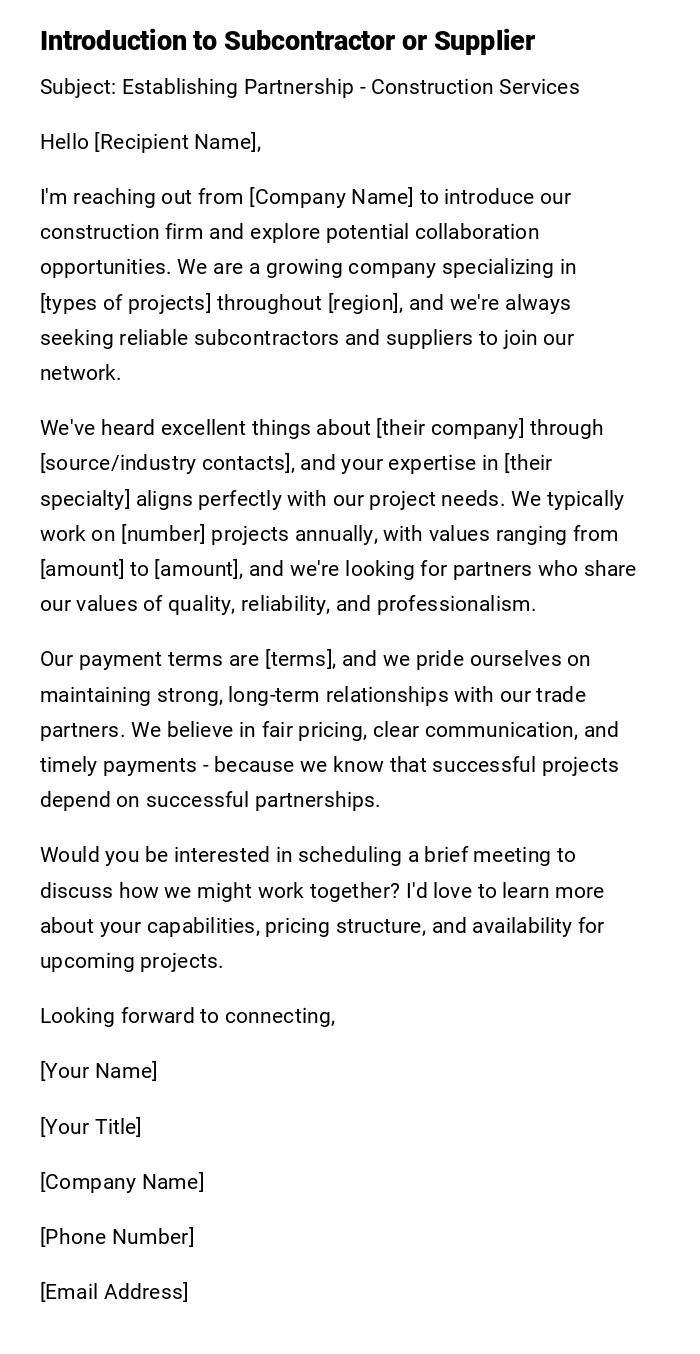
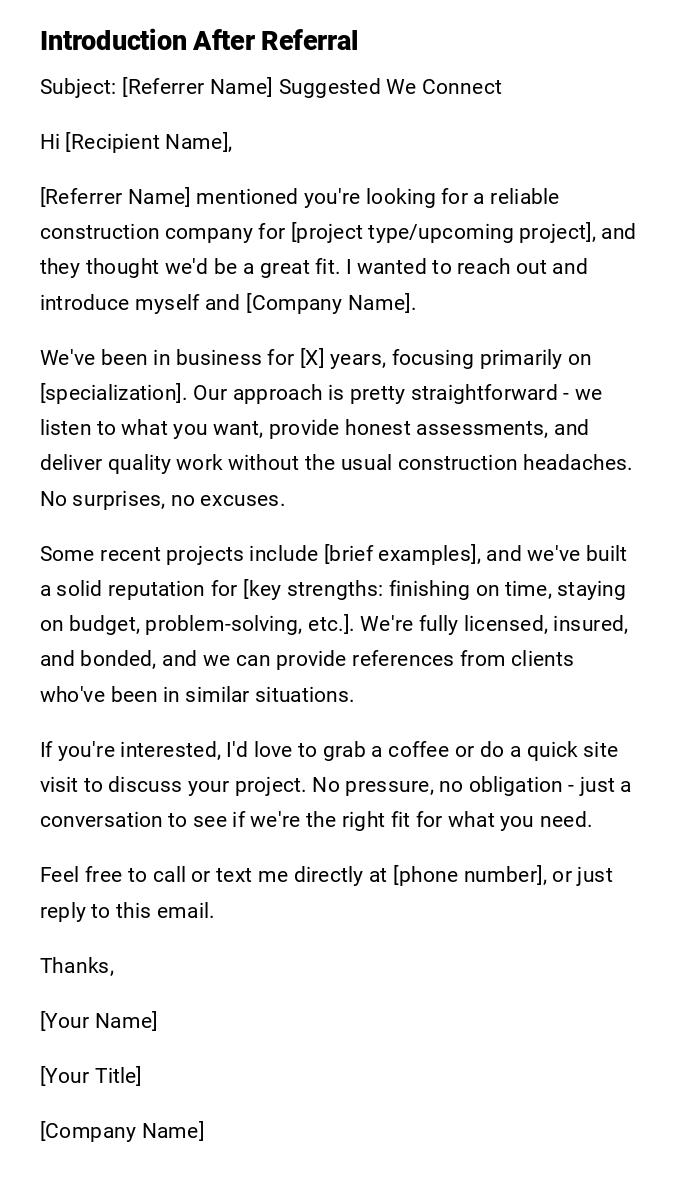
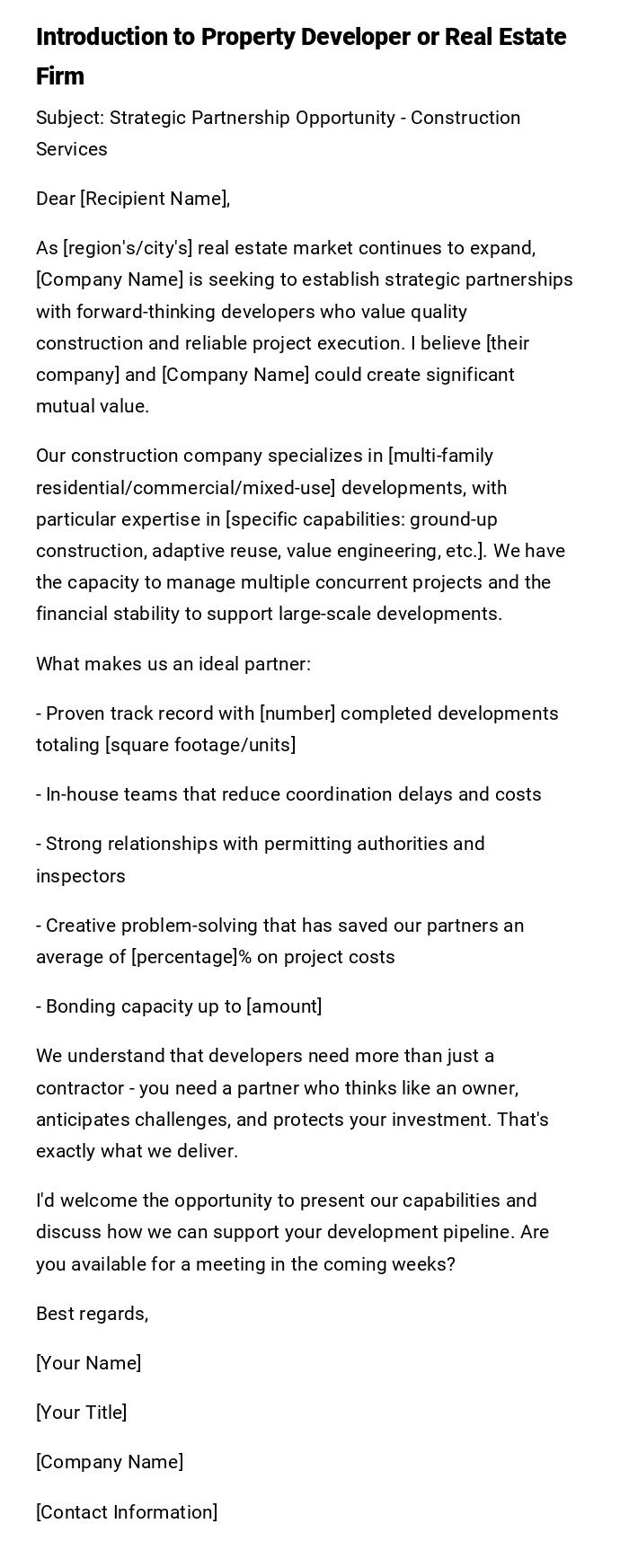
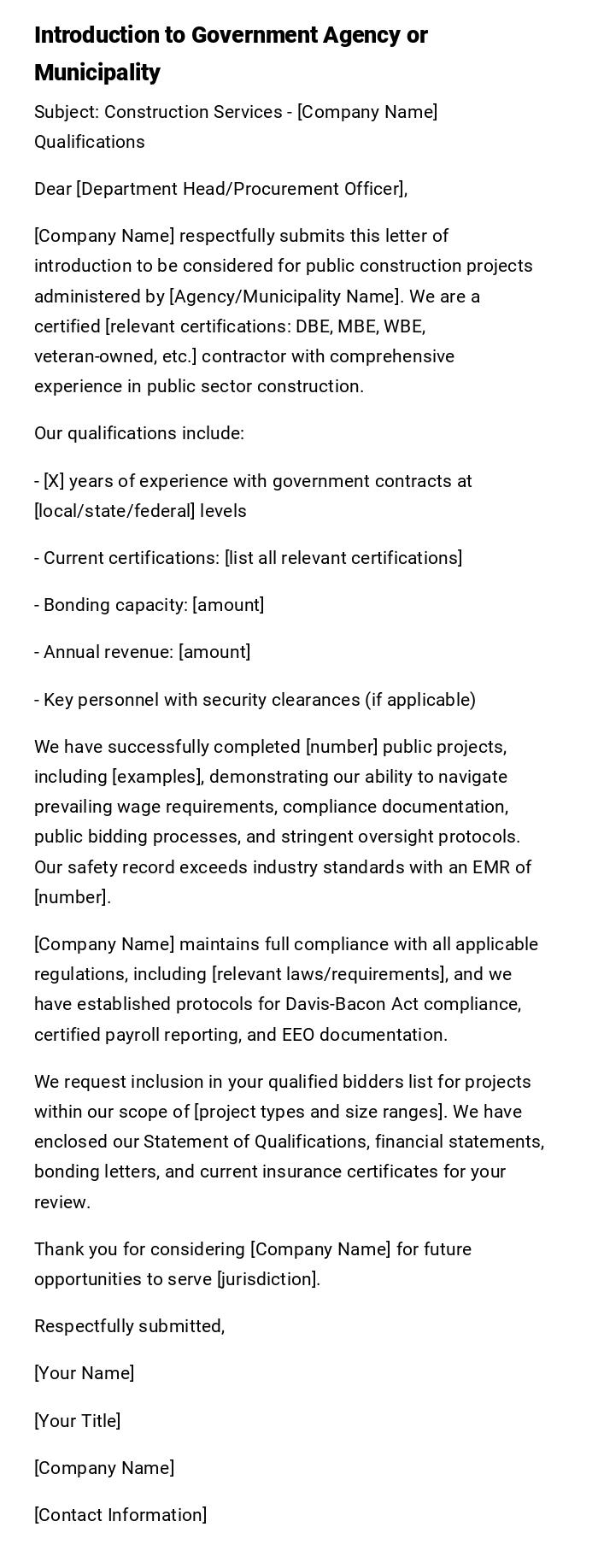
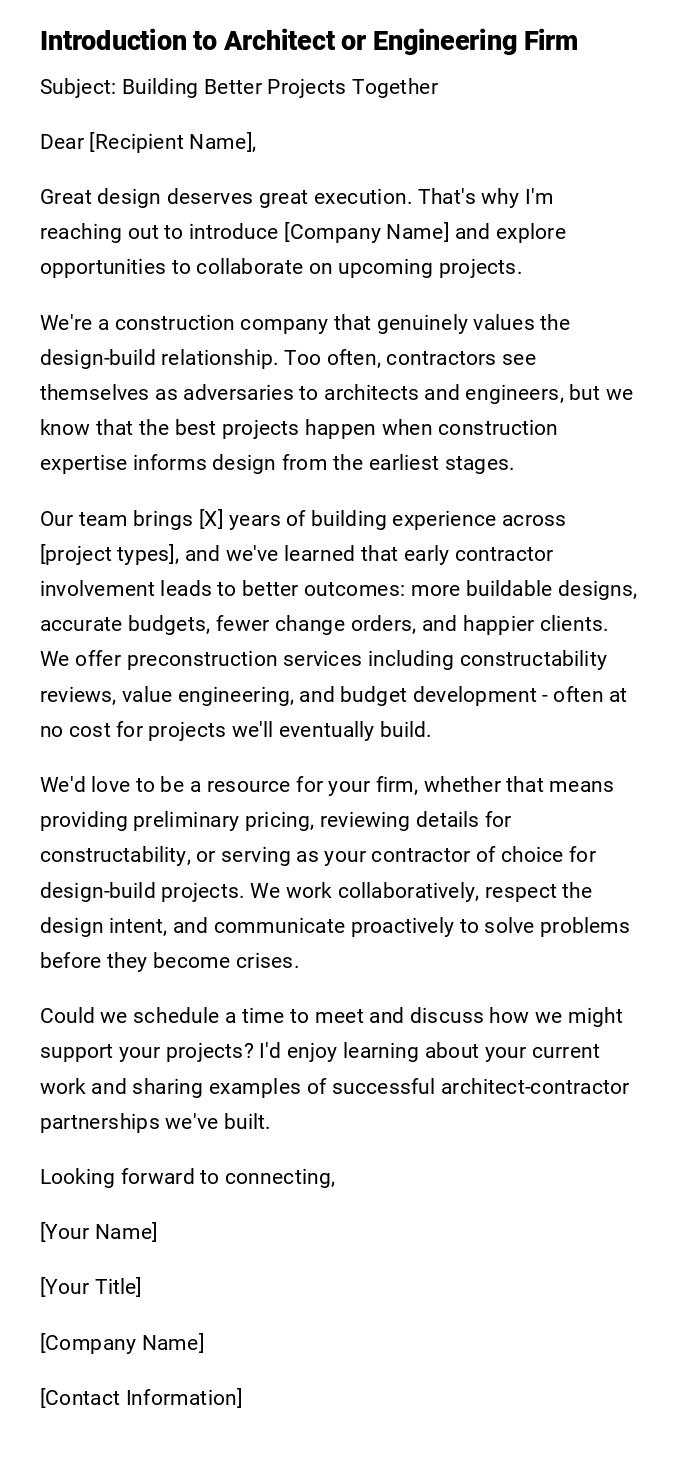
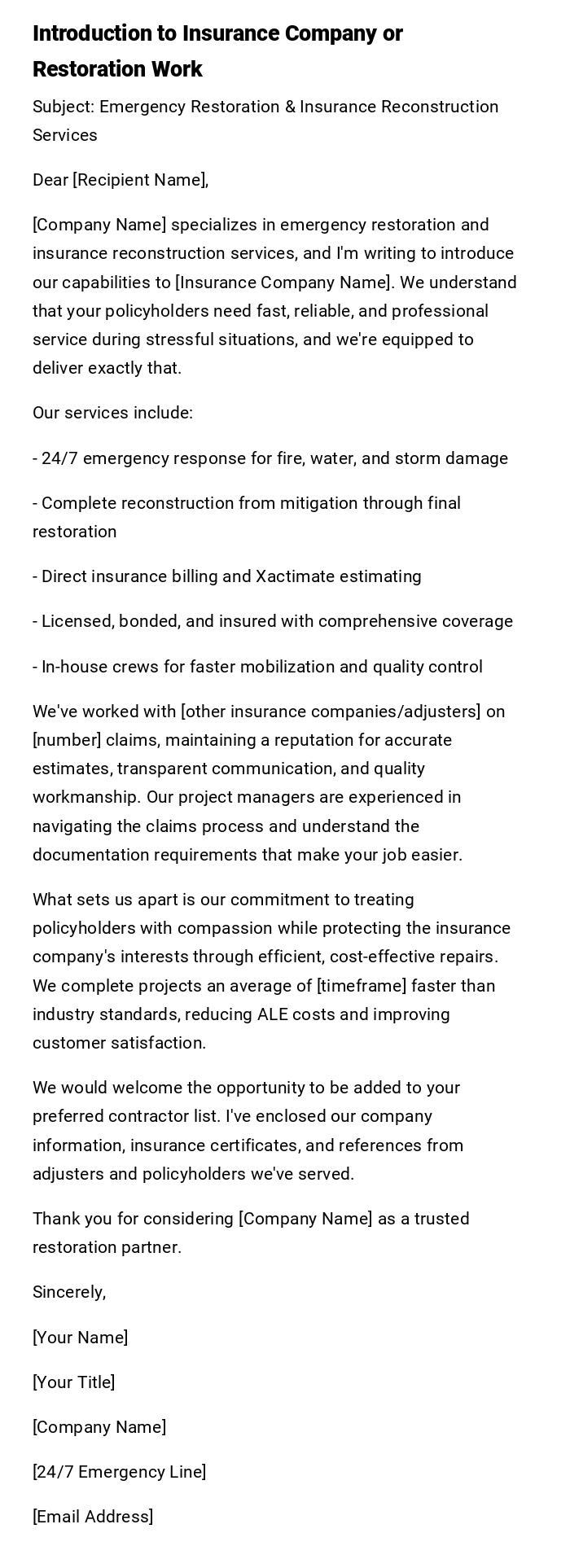

 Download Word Doc
Download Word Doc
 Download PDF
Download PDF